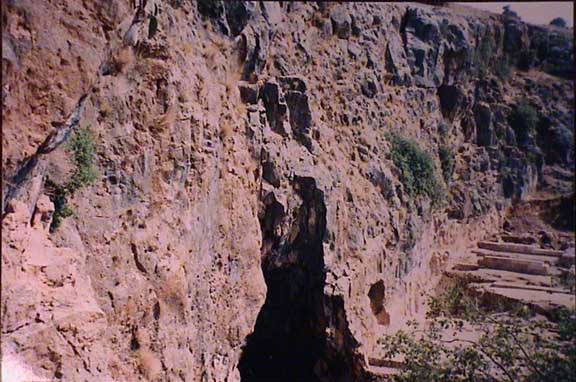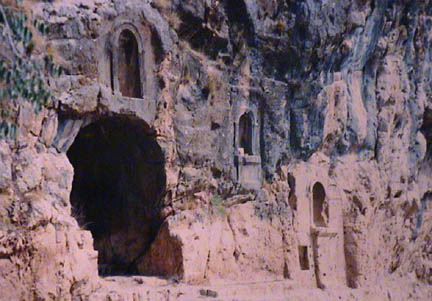Library
Part II – Near, not in Caesarea ?? Relevant ???
Seeing the Context at Caesarea Philippi
Part III - Keys of the Kingdom
Part IV - Pagan god Pan Vs Jesus
Part V - Christ Defeats Pan
|
DEFENDING THE BRIDE
|
Peter the Rock and Caesarea Philippi
Part I – Peter the Rock at Caesarea Philippi
Part II – Near, not in Caesarea ?? Relevant ???
Seeing the Context at Caesarea Philippi
Part III - Keys of the Kingdom
Part IV - Pagan god Pan Vs Jesus
Part V - Christ Defeats Pan
Part I – Rock at Caesarea Philippi
Wall (2)
Why is the Reference to Caesarea Philippi so Important ?
Matthew 16:13-19
“When Jesus went into the region of Caesarea Philippi …
He said to …Simon Peter … you are Peter, and upon this rock I will build my
church …”
The Bible tells us that besides what is recorded there are many more things that Jesus did which could have been included in the Bible, but were not. [John 21:25] So, we know that there are no wasted words in the Bible. In Matthew’s Gospel chapter 16 we are told about a very important teaching of Jesus Christ, how He would build His Church. And this took place when they entered into the region of Caesarea Philippi.
There are two especially visually striking pieces of landscape in Israel. The most prominent is the rock around which the Temple in Jerusalem was built. The second is the massive wall of rock at Caesarea Philippi.
Theological Significance
Caesarea Philippi is in the northeast section of Israel called the Golan Heights and was near the ancient city of Dan. It is important not to confuse it with the other Caesarea on the Mediterranean coast. In Israel all of the important church’s, temples, and synagogues were built on the top of hills and mountains. They were never placed in low areas such as the valleys or coastlands. Caesarea Philippi is in the foothills of Mount Hermon which is in Syria. Mount Hermon is the largest mountain in the whole area towering 2,814 meters above sea level. To get an idea of how high that is consider that the Temple Mount in Jerusalem is about 741 meters above sea level. In Arabic Mount Hermon is called “Jabal ash Shaykh” which means “Mountain of the Chief.”
And it was to Caesarea Philippi that Jesus came to proclaim that He would build His Church which would point to the True Chief, the True Master and Lord, the One True God.
At Caesarea Philippi there is a massive wall of rock that is well over 100 feet straight up and about 500 feet wide. The city of Caesarea Philippi was built on top of this enormous rock. It was enlarged and rededicated by King Philip to honor the Caesar in Rome. Caesar considered himself a god and King Philip was eager to please him. The Greek and Roman cultures had many gods. Another god that was especially honored here in Caesarea Philippi was the Pagan god of Pan.
More details on the theological significance Pan will be
discussed in
Part IV - Pagan god Pan Vs Jesus
Niches in the rock below contained statues of Pan
So, Caesarea Philippi was built on top of this wall of rock to give honor to these false gods, Caesar and Pan. And this rock is an extremely impressive sight. It towers over 100 feet straight up. However, in contrast Jesus makes Simon the Rock by changing his name to Rock, “Kephas” in the Aramaic language that Jesus Spoke, “Peter” in English, and “Petros” in Greek. See Who is the Rock ?
While the rock that Caesarea Philippi was built on is an impressive sight, Peter, by Christ’s decree becomes even a greater Rock because the ROCK-ness of Jesus Christ works through him making him a Rock. And upon him Jesus builds His Church to honor the One True God.
Matthew 5:14
“You are the light of the world. A city set on a mountain cannot
be hidden.”
Matthew
16:13-19
“When Jesus went into the region of Caesarea Philippi he asked his
disciples, ‘Who do people say that the Son of Man is?’
They replied, ‘Some say John the Baptist, others Elijah, still others
Jeremiah or one of the prophets.’
He said to them, ‘But who do you say that I am?’
Simon Peter said in reply, ‘You are the Messiah, the Son of the living God.’
Jesus said to him in reply, ‘Blessed are you, Simon son of Jonah. For flesh
and blood has not revealed this to you, but my heavenly Father.
And so I say to you, you are Peter, and upon this rock I will build my
church, and the gates of the netherworld shall not prevail against it.
I will give you the keys to the kingdom of heaven. Whatever you bind on
earth shall be bound in heaven; and whatever you loose on earth shall be
loosed in heaven.’ ”
Close up of Temple ruins at the base of the rock
Matthew 16:13
“When Jesus went into the region of Caesarea Philippi he asked his disciples
…”
Now, some people have contended that because Matthew in 16:13 says the Jesus and His disciples had gone into the “region” or “area” of Caesarea Philippi, rather than saying that He actually went into the city, that this makes any analogy to the city being built on this huge rock invalid. However, my pilgrimage to Caesarea Philippi revealed the exact opposite. The case for comparing and contrasting this city being built on top of this huge rock with Jesus who said He would build His Church on the Rock of Peter is stronger, not weaker, than if the text said that they were in the actual city. Please read the next section to see why this is so.
See
Part II – Near, not in Caesarea ?? Relevant ???
Seeing the Context at Caesarea Philippi
|
Who is the Rock ?
If Peter is the rock that the Church is built on, then why does the Greek say “ … you are “Petros” and upon this “petra” I will build my church …” ? Actually Jesus Christ spoke in Aramaic. And He used the Aramaic word for rock which is “Kephas.” See John 1:42 below. So, Jesus’ actual words were “… you are Kephas, and upon this Kephas I will build my Church …” [The words not underlined are translated into English.] In Paul’s letters he continued to use this Aramaic name for Peter. Cf. 1 Corinthians 15:5, etc. Matthew translated that into Greek when he translated his original Aramaic Gospel into the Greek. However, in Greek words have gender, that is, some words are feminine and some words are masculine. Spanish is the same way. For example, the Spanish word for “milk” is “leche” which is feminine and so it always takes feminine adjectives. In Matthew 16 the second usage of “Kephas,” which means rock, the Apostle had no problem translating it to the root word for rock in the Greek which is “petra.” However, “Petra” is feminine. The masculine form of that word is “Petros.” So when Matthew translated the first instance of “Kephas” into Greek he used the masculine form of the word to keep it consistent with the male person it referred too. Actually, the parenthetic note that is part of John’s Gospel chapter 1 verse 42 informs us that Jesus really called Peter “Kephas” and that this name was later translated to “Peter,” or actually “Petros” in the Greek text of Matthew’s Gospel. John 1:42 Some English translations substitute “Peter” for “Petros” which is in the Greek text for the above verse. Also the context itself precludes the mistaken notion that Jesus was putting Peter down in some way. Consider the five things that Jesus declares to Peter in Matthew 16 verses 17 through 19.
1. “Blessed are you, Simon son of Jonah.”
2. “For flesh and blood has not revealed this to you, but my heavenly Father.”
5. “Whatever you bind on earth shall be bound in heaven; and whatever you loose on earth shall be loosed in heaven.”
Declarations 1, 2, 4, and 5 are unquestionably favorable to Peter. If declaration number 3 was unfavorable to him it would be totally inconsistent if not contradictory and it would make the whole dialogue confusing if not incomprehensible. Therefore, both the original language of Aramaic where only one word for rock is used and the context itself shows that Simon is now the Rock on which Christ builds His Church. The renaming of Simon as “Rock”
In the book And On This Rock, by Stanley L. Jaki, page 73-74, we read, “Obviously the rock here symbolizes not strength but barrenness, a condition common to both Abraham and Sarah, which only God’s power could overcome … life giving waters out of the rock struck by Moses.” By renaming Simon as Rock, or Peter, Jesus is showing how God will make him a Rock and how God chooses to work through him for our benefit. See
|
See Articles at


